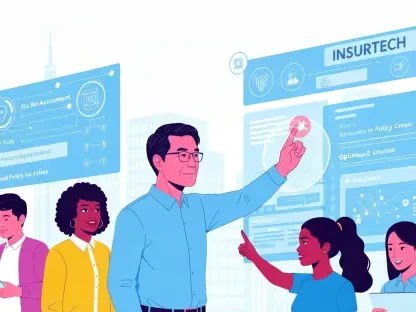I’m thrilled to sit down with Simon Glairy, a leading voice in insurance and Insurtech, particularly renowned for his deep expertise in risk management and AI-driven risk assessment. With a career dedicated to pushing the boundaries of how technology can transform the insurance landscape, Simon is the perfect person to unpack the latest innovations in the industry. Today, we’re diving into the exciting world of embedded insurance and AI optimization, exploring how these advancements are reshaping customer experiences, enhancing personalization, and empowering digital partnerships. Let’s get started with how cutting-edge platforms are changing the game.
Can you explain what platforms like Chubb Studio are and how they’re driving the concept of embedded insurance?
Absolutely, Olivia. Platforms like Chubb Studio are digital ecosystems designed to integrate insurance offerings directly into the apps and services customers use every day. Think of it as a bridge that connects insurers with online marketplaces, payment apps, or even payroll systems. The goal of embedded insurance is to make protection a natural part of a customer’s journey—whether they’re shopping, booking travel, or managing finances—without it feeling like a separate or cumbersome step. These platforms provide the tech backbone to seamlessly weave insurance into those moments, often through partnerships with non-insurance businesses.
How does AI play a role in optimizing the way insurance products are presented through such platforms?
AI is a game-changer here. It powers what I’d call an optimization engine that analyzes vast amounts of data—like customer behavior, preferences, and even the context of their current activity—to suggest the right insurance product at the right time. For instance, if someone’s buying a high-value item online, the AI might recommend a protection plan for that purchase instantly. It’s all about relevance and timing, using real-time data to ensure the offer feels helpful rather than intrusive. This level of personalization wasn’t possible with older, manual approaches.
What are some of the biggest challenges traditional insurance methods faced that AI-driven solutions are now addressing?
Traditional methods often relied on static, one-size-fits-all campaigns or manual design of insurance offers, which could miss the mark with customers. Timing was a huge issue—offers might come too late or feel irrelevant. Plus, there was little ability to adapt on the fly. AI solves this by dynamically tailoring recommendations based on live data and user interactions. It cuts through the guesswork, making the customer journey smoother by presenting options that actually match their needs at the moment they’re most likely to engage.
Can you dive into how real-time analytics within these AI systems benefit the partners who distribute insurance?
Real-time analytics are incredibly powerful for distribution partners. They provide ongoing feedback on how campaigns are performing—think insights into which messages resonate, the best times to present offers, or even which formats drive clicks. Partners can use this data to tweak their approach instantly, whether it’s changing the wording of an offer or adjusting when it pops up. This agility helps maximize engagement and conversion rates, ensuring that both the partner and the insurer get better results from their efforts.
Personalization seems to be a core focus of these innovations. Can you share how AI determines the context of a customer’s situation to tailor insurance offerings?
Personalization through AI is all about understanding the ‘why’ and ‘when’ behind a customer’s actions. It looks at signals like what they’re purchasing, their browsing patterns, or even life events hinted at through their digital footprint. For example, if someone’s booking a trip abroad on a travel app, the AI can infer they might need travel insurance and present a tailored option right there during checkout. It’s about connecting the dots between their current context and a relevant protection need, making the offer feel intuitive rather than random.
Why do you think embedded distribution is becoming such a significant trend in the insurance industry right now?
Embedded distribution taps into a fundamental shift in how people interact with services today. Customers want convenience and solutions that fit into their existing digital habits. Insurance, historically seen as a standalone product, is now being reimagined as a complementary service within broader ecosystems like retail, fintech, or even gig economy platforms. Businesses ranging from e-commerce giants to payment processors see value in offering insurance as an add-on because it builds trust and adds revenue streams. It’s a win-win, aligning with the broader push toward integrated, customer-centric experiences.
How do these technological advancements support the relationship between insurers and their digital distribution partners?
These advancements create a symbiotic relationship. Insurers bring their expertise and product portfolios, while AI tools provide partners with actionable insights and flexible integration options. Partners get access to data on customer interactions and campaign performance, which helps them refine their strategies. Meanwhile, integration models—whether fully managed by the insurer or led by the partner—allow for customization based on the partner’s tech setup or goals. It’s a collaborative approach that ensures both sides can focus on delivering value to the end customer.
What’s your forecast for the future of AI and embedded insurance in shaping the industry over the next few years?
I’m incredibly optimistic about this space. Over the next few years, I expect AI to become even more sophisticated in predicting customer needs, potentially integrating with emerging tech like wearable devices or smart home systems to offer hyper-contextual insurance in real time. Embedded insurance will likely expand into more niche markets and everyday interactions, becoming as commonplace as adding a warranty at checkout. The focus will be on reducing friction further, making enrollment instantaneous, and using AI to anticipate risks before they even occur. It’s an exciting time, and I think we’re just scratching the surface of what’s possible.









